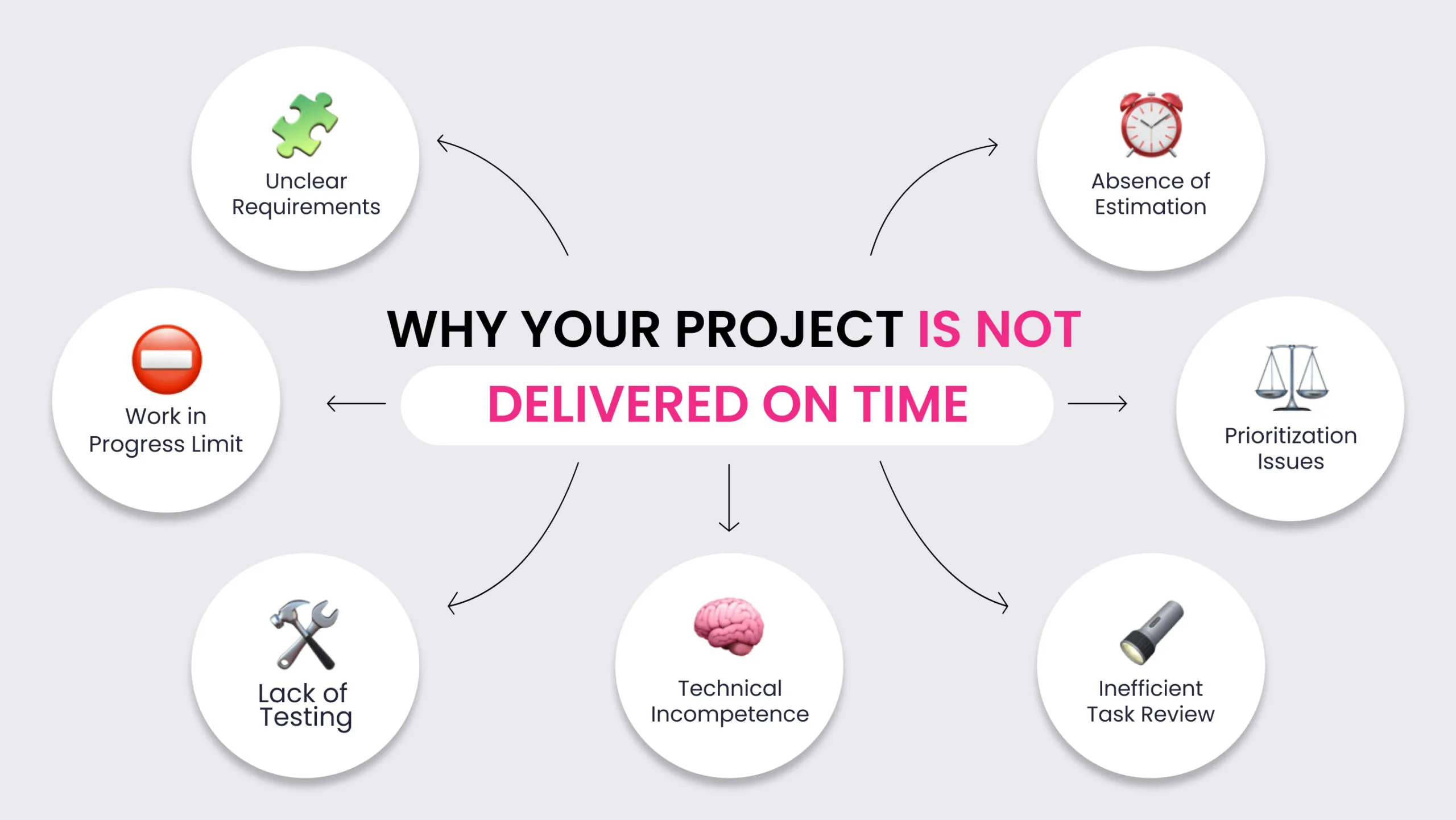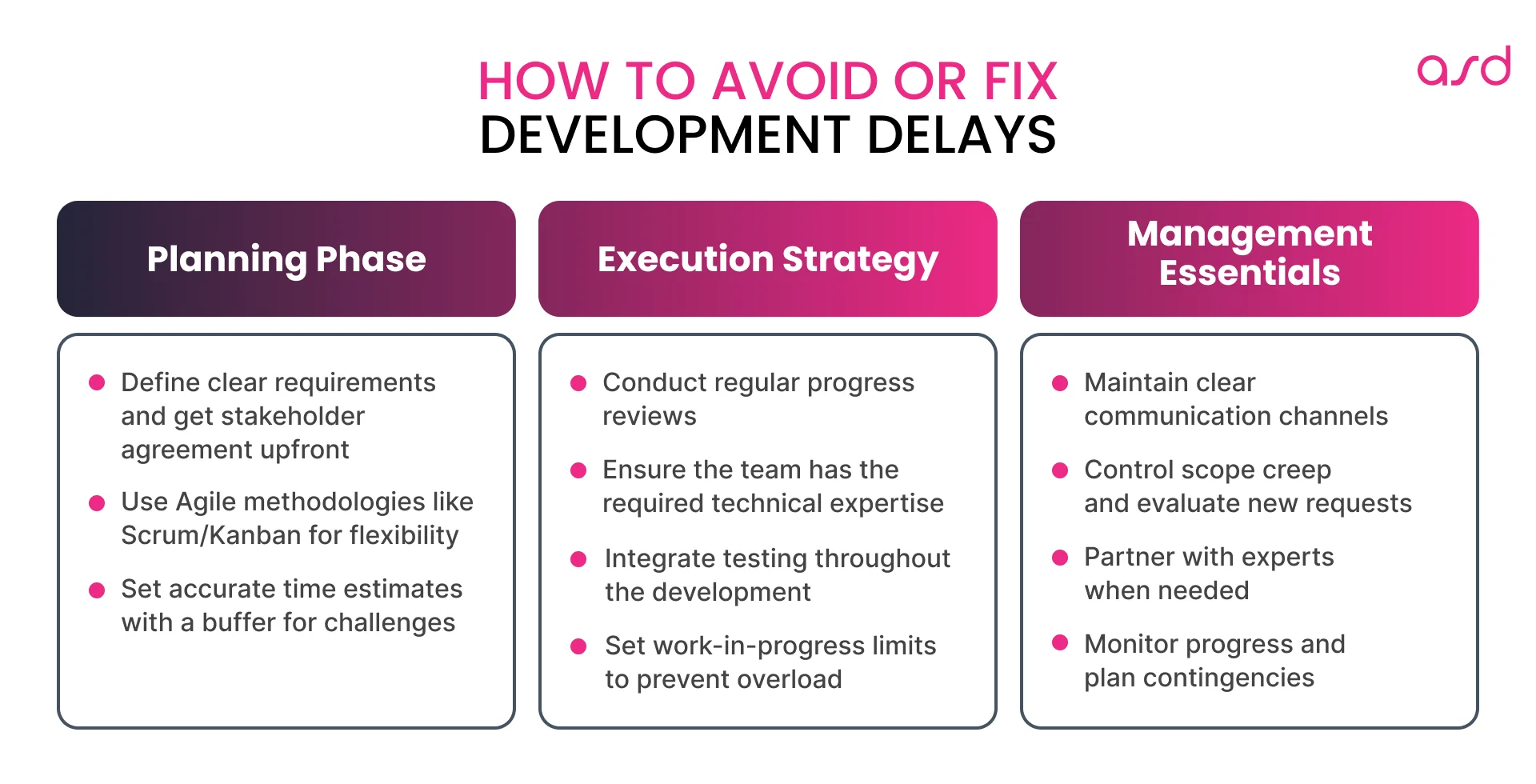Table of Content
- Understanding Project Delays
- Reasons why you have Delays
- Team and Resource Challenges
- Communication and Decision-Making Challenges
- How to Avoid and Fix Development Delays
- Managing Software Projects Effectively
- Expert Advice on figuring out your Project Delays
Hire a team that delivers on-time
Book a call
Having a team of developers working on the product you’ve been passionately sculpturing for years is overwhelming, confusing, and stressful. Especially, when you keep receiving news about another feature delay because of A, B, or C problems from your team. Efficient software development is crucial to avoid these delays and maintain a competitive edge. Development teams play a vital role in preventing delays by implementing effective methodologies like Agile. What can you do? How to fix it? Should you fix it? Thousands of questions are popping out every day and we are here to answer them.
If you have been spinning in this cycle of endless late deliveries for too long and feel fed up with all these software development challenges, then you are not alone in this. As it’s stated in Forbes, 7 out of 10 software projects are delivered not within the previously set deadlines. So, why are software projects always late? Let’s work our way to figure out reasons for software project delays, but for that, we need to take a step back and look at the roots of the problem.
Does it sound like your situation? Get an expert advice on how you can fix missed deadlines at your software project

To highlight, the correct software development flow consists of three key elements:
Technical Design: This part is all about creating requirements with further planning, and estimating your software product based on them. It is the most important step because it is how you know what your team is going to do, what the result will be in the end, and how it will work.
Development: Based on the previous step, developers start coding the project, turning defined plans into functioning features.
QA Testing: At this step, your QA engineer detects bugs, while you check if the result matches your expectations.
When all these steps exist in your development flow, and are done right, then it equals on-time delivered features and happy you. When any of these steps fails, the whole project is delayed.
Understanding Software Development Project Delays
Software development project delays are a common phenomenon that can have significant consequences on a company’s bottom line. Delays can lead to missed deadlines, stalling progress, hindering the ability to ship a high-quality product to market, and be cause of turning to a software prokect rescue services. Understanding the roots of software delays is crucial to avoiding them. A delay is defined as a missed expectation, where something was expected to be in a particular state at a specific time, but it’s not there. Software development companies can set reasonable and achievable expectations and engineer their products and processes to avoid delays, with the right software development partner, of course.
Reasons why you have Software Project Delays

1. Unclear requirements
Imagine a situation: you are managing the launch of a new project to create an advanced analytics open data portal that provides users with customized financial dashboards. You want people to enhance the effectiveness of their datasets with the help of a user-friendly interface. However, your first and easy step is to create a basic login page.
So, you come to your developers with a request: “I want a simple login page”.
The developer’s team says it will take them three days to code the login page and make it work. Next thing, changes are deployed on the testing environment, and emails with a page are sent for review. A few days later you receive feedback from the marketing team. They suggest that customers should be able to log in using their Apple ID information. You agree that an Apple login would be more comfortable and secure.
After that, you contact the team to inform them of the new request. The team says that it will take another ten days to properly implement the feature and ensure security across Apple devices and operating systems. You are upset that you have to extend the deadline. That means that the development team also has to change their task priorities and allocate more resources to meet the new deadline for the login feature. This affects other parts of the project and leads to development delays and changes in the project’s schedule and budget.
Project stakeholders often have a strong desire to expedite product release, which can lead to unrealistic expectations regarding project timelines. This can further complicate the balance between delivering high-quality software, staying within budget, and adhering to a swift delivery schedule.
How do you know that your problem is requirements-wise?
- You don’t have documented requirements (in a shared repository)
- Your requirements don’t specify user flow
- You change requirements before feature delivery
- You generate requirements inconsistently
- You give only UI design tasks with no descriptions
2. Not efficient task review
Now you are starting to test your login page. You decide to do it on your mobile to check how it’s working but forget the password and see no “Forgot Password?” button.
You realize that you had to discuss the need for such a feature during the meeting with the development team. It seems like an error on both sides, a crucial detail left untouched in the rush of assigning tasks and discussing software development requirements. You think about this mistake and understand the importance of efficient task review. If a small issue is not addressed properly, it may quickly become a major pitfall.
Software developers often face challenges due to unclear requirements and overly optimistic estimates. Proper planning and communication are essential to prevent delays and ensure that developers are not overwhelmed by shifting project expectations.
You quickly gather the team for a discussion. Together you examine the impact of adding a “Forgot Password?” feature and balance it against the project’s timeline and resources. The team recognizes its importance in providing a user-friendly experience. This critical failure results from the fact that during the review session, neither did the developers ask about the need for this button, nor did you specify the requirement.
Signs that you most likely deal with inefficient task review:
- You don’t have review meetings with developers at all
- You don’t have an organized and structured plan during the meeting
- You have no team managers who are responsible for task-reviewing process
These signs can be a solid indicator that some work needs to be done. It is important to keep in mind that inefficient grooming can create a domino effect, which will cause more bugs to be fixed in the development process, and, as a result, lead to an overall software development delay problem.
3. Absence of estimation
After successfully integrating the “Forgot Password?” feature, the next step is to integrate an email notification. The developer estimates it to code in 1 day. In the process of coding, the development team comes and says that they have connected to the local server but it doesn’t send email. To fix that, they will need at least four more days. You sigh but have no other option than to extend the deadline again. Four days pass and they come back with feedback: “We have no connection to the server that sends the emails“.
Now you have to invest another $100 and give your developers some time to connect to a suitable mail server. The team gathers, considers alternative approaches, and analyzes the costs and benefits of each option. You look at everything from outsourcing email server setup to looking for open-source solutions.
The whole problem was in the absence of estimation steps. First of all, at the review session, you had to make sure that all the tasks were divided into sub-tasks for precise estimation of completion of each step. That would help reveal hidden processes and estimate the time of steps like connection to the servers. This way it wouldn’t be a shock to you that it could take a few more days. Usually, estimation includes breaking down the project into smaller pieces, which you didn’t do before. The project is delayed again and you are annoyed again as well because of missed deadlines.
Working with an experienced software development company can ensure accurate estimations and prevent such delays. They can handle unforeseen challenges and manage staffing changes to maintain project momentum.
So, what can be wrong with your estimation process?
- You did not facilitate a separate estimation meeting
- There was no separation of the task into subtasks
The truth is there is no progress without a clearly defined software project estimation step. You will not be able to measure project progress, set expectations, and meet deadlines effectively without it. Next time you are arranging tasks pay attention to your estimation process. By the way, here is another thing that can delay your software project: technical incompetence.
4. Technical incompetence
Your development team continues to progress despite challenges. After finishing coding an email system, they switched to working on setting up and integrating the mail server. The work is going steadily. You finally catch a breath imagining that your login page launch is right around the corner. Well, not exactly. At a weekly meeting, one of your developers says: “We have a problem with integrating the mail server connection library to the current code”.
Just as the mail server was finally connected, this challenge once again put the team’s progress in danger. The team’s technical incompetence comes out at the worst time possible. No one has the expertise to navigate this library from your team, and you have no idea what to do.
Collaborating with a reliable software development vendor can provide the necessary expertise to overcome such technical challenges, ensuring timely project delivery and adherence to contractual obligations.
Stress remains in your team, as you face technical challenges in software development and technical incompetence from people that are supposed to do their job diligently. You refuse to give up and start making quick (and expensive) decisions. You reach out to your ex-partner of the previous startup you worked with and ask for the contact of the senior developer your partner has been on a team. You need the expertise of a professional and you get it. This developer agrees to help you but charges double the market price since you request to finish this task ASAP. In a short time, the work is done but you are left stressed and overwhelmed by your incompetent team and the additional expenses they brought.
Sorry, but there is only one reality check right here:
- Developers are chosen by someone who does not have technical expertise
You must ensure that everyone on your team is technically competent before you hire a software development team. Otherwise, the snowball of technical insolvencies will become bigger and one day destroy your product.
5. Lack of testing
As the long-awaited launch date approaches, you get a relaxed feeling. Finally, the login page is done and you will be proud of the result. Without a moment of hesitation, you approve the launch and the next day decide to check it. As you are going through each detail and feature of the page, you realize that there is a two-character password set up on your login page. This can result in a huge security problem for your users.
A standard 8-character password should be enough, but your development team needs time to do it. That also means you need to pause the launch. You are frustrated. Why no one do testing before this exact moment? You have no time to waste. That’s why you call the team in for an immediate meeting to fix this problem as soon as possible.
Signs that software development delays are due to the lack of testing:
- You do testing by yourself
- Your developers do testing
- You do not have the testing in plans at all (which is the worst sign)
- You have no security testing
- Edge cases are not taken into account (1 or 999 characters)
Testing is some kind of a safety net for your project. Without it, one small bug can lead to a major disaster. That’s nice if you did testing in the right way, but how to prioritize what tasks should be finished first?
6. Prioritization
As the focus shifts to solving the password difficulty, a deeper issue lies beneath. The previous problem derives exactly from the fact that no one prioritized testing a login page before the launch date. The absence of prioritization delayed the project, as your team focused on tasks that were not high priority at the moment. As a matter of fact, you didn’t even have a categorization of tasks by their priority range. Why?
Prioritization is necessary to ensure that important features, such as password recovery or login testing before the launch are prioritized among other tasks. This creates the right workload and reduces stress all over the team. It doesn’t take a lot of time, as you can do it during the meeting by preparing a plan beforehand. Efficient software development practices are crucial in prioritizing tasks and preventing delays, ensuring timely project completion.
Signs you have prioritization issues in your project:
- You don’t have a stable prioritization plan
- You and your team don’t have a clear task board
Yes, you got it that your team might need more clear task prioritization. But even with that onboard, the project still isn’t moving forward the way you want and you face software project delay once again. What’s the problem now?
7. Work in progress limit
As your developers make sure an 8-character password improvement takes a day to make, you have a security analyst on board claiming you need hash functions to add as well. You approve that request and set up a meeting with your development team to include it in the process of coding. Seems like everyone understood each other. The next day you return to see if the task has been completed, and your hopes are destroyed again.
You are upset because the 8-character password improvement remains unfinished. The development team was overwhelmed with doing an additional task from a security analyst, and they didn’t put a limit on the number of hours they could dedicate to each task. Instead of doing one task at a time, they simply tried to do everything at once and ended up needing more time to finish both tasks.
Development teams often face significant challenges when there are no limits on the number of tasks in progress. This can lead to delays and decreased efficiency, making it difficult to deliver software projects on time.
Now you start realizing that you need to include WIP limits in your project to prevent bottlenecks and create a smoother workflow. These limits usually foster a culture of “stop starting, start finishing”. The more work your team tries to do at once, the worse result you have at the end of the software development cycle and the software project will be late again.
Signs that you developers might struggle with WIP limits:
- There is no task-tracking in the team
- There are no limits to how many tasks are in progress
- Tasks are just randomly assigned to progress the project
- Tasks are pushed to progress when it’s obvious the team is overwhelmed with the tasks list.
Team and Resource Challenges
Team and resource challenges are common causes of software project delays. Losing key team members can significantly impact the project timeline, and finding a replacement can be time-consuming. Insufficient resources, including budget, personnel, or equipment, can also cause project delays. Effective project management and business analysis play vital roles in assessing, coordinating, estimating, and overseeing the development process. To ensure timely completion and delivery, the project development team and its members must possess robust qualifications and experience.
Communication and Decision-Making Challenges
Communication and decision-making challenges can also lead to software project delays. Delays can arise if stakeholders are hesitant about making decisions or too slow in their replies. The development team will often rely on guidance and seek input on various requests, both simple and crucial. Missing these engagements can lead to project delays. To address this, maintain consistent communication with the development team to keep the project on track. Regular meetings, feedback, and open communication channels can help avoid development process delays.
How to Avoid and Fix Development Delays
Development delays can be frustrating and costly, but they are not inevitable. By implementing proactive strategies and addressing common pitfalls, you can minimize the risk of delays and keep your project ready on-time. Here are some actionable steps to avoid or fix development delays:
1. Define Clear Requirements
- Avoid: Unclear or constantly changing requirements are one of the top causes of delays. Ensure that all stakeholders agree on the project scope and features before development begins.
- Fix: If requirements are unclear mid-project, hold a workshop with stakeholders to clarify expectations. Document all changes and communicate them to the development team immediately.
2. Implement Agile Methodologies
- Avoid: Rigid development processes can lead to bottlenecks. Agile methodologies like Scrum or Kanban promote flexibility and continuous improvement.
- Fix: If your team is struggling with delays, consider adopting Agile practices. Break the project into smaller, manageable sprints and prioritize tasks based on business value.
3. Conduct Regular Task Reviews
- Avoid: Skipping task reviews can lead to overlooked details and inefficiencies. Regular reviews ensure that tasks are on track and align with project goals.
- Fix: Schedule weekly or bi-weekly review meetings to assess progress, identify roadblocks, and adjust priorities as needed.
4. Accurate Time Estimation
- Avoid: Underestimating the time required for tasks is a common mistake. Always include buffer time for unforeseen challenges.
- Fix: Break tasks into smaller subtasks and estimate time for each. Use historical data from past projects to improve accuracy.
5. Ensure Technical Competence
- Avoid: Hiring developers without the necessary expertise can lead to technical debt and delays.
- Fix: If your team lacks expertise in a specific area, consider outsourcing a team with needed expertise, hiring external consultants, or upskilling your current team through training.
6. Prioritize Testing
- Avoid: Skipping or delaying testing can result in last-minute bugs and security issues.
- Fix: Integrate testing into every phase of development. Use automated testing tools to catch issues early and ensure quality.
7. Set Work-in-Progress (WIP) Limits
- Avoid: Overloading your team with too many tasks at once can lead to burnout and inefficiency.
- Fix: Implement WIP limits to ensure that your team focuses on completing tasks before starting new ones. This promotes a smoother workflow and reduces bottlenecks.
8. Improve Communication
- Avoid: Poor communication between stakeholders and the development team can lead to misunderstandings and delays.
- Fix: Establish clear communication channels and hold regular stand-up meetings to keep everyone aligned. Use collaboration tools like Slack or Jira to track progress.
9. Manage Scope Creep
- Avoid: Adding new features mid-project without adjusting timelines or resources can derail progress.
- Fix: Evaluate the impact of any new requests on the project timeline and budget. If necessary, defer non-essential features to a later phase.
10. Leverage External Expertise
- Avoid: Trying to handle everything in-house without the necessary expertise can lead to delays.
- Fix: Partner with a reliable software development company to fill skill gaps, provide additional resources, and ensure timely delivery.
11. Monitor Progress Continuously
- Avoid: Failing to track progress can result in missed deadlines and unexpected delays.
- Fix: Use project management tools to monitor task completion, identify bottlenecks, and adjust timelines as needed.
12. Plan for Contingencies
- Avoid: Not having a backup plan for unexpected issues can lead to significant delays.
- Fix: Identify potential risks early and develop contingency plans. Allocate resources to address issues quickly if they arise.

By following these strategies, you can significantly reduce the likelihood of development delays and ensure that your project stays on schedule. Remember, proactive planning, clear communication, and continuous improvement are key to successful software development. If you’re already facing delays, take a step back, identify the root causes, and implement the necessary fixes to get back on track.
Managing Software Projects Effectively
Managing software projects effectively is crucial to avoiding delays. Effective project management involves comprehensive specifications or requirements, thorough planning, and effective management. A good project manager adds a buffer to estimates to account for unknowns and ensures that the development team is not overwhelmed with an excessive number of concurrent priorities. To mitigate the risks of project delays, it is essential to thoroughly review and align the requirements with the project vision and overall business strategy. By focusing on these aspects, you can optimize resource allocation, minimize costs, and ensure predictable outcomes while building your solution within the established timeframe.
Expert Advice on figuring out your Project Delays
If you recognize multiple causes of delays in your projects, it’s time to review and optimize your software product development process. Anyway, we understand that sometimes clients want perfect outcomes, but if your team delivers 80% of the features customers have requested, consider it a standard. In case a team does less, you better establish your workflow and finally solve this software development challenge.
Get free check-up of your software project?
For personalized advice, sign up for a FREE check-up of your project delivery. It is basically 2-3 meetings lasting 45 minutes each with one of our technical experts who will help you identify the key challenges and causes of software project delays at your company and how they can be solved.
Collaborating with a reliable software development vendor is crucial to ensure timely project delivery and adherence to contractual obligations.
Set clear, achievable goals and deadlines. Regularly communicate with your team and stakeholders. Use agile methods to stay flexible and address issues as they arise. Prioritize tasks and manage scope to keep the project on track.
Developers fail to deliver projects on time due to poor task estimation, which can lead to unrealistic timelines and unexpected delays. Without proper planning and estimation, it is difficult to move forward as planned.
Software project delays may be due to inefficient management processes. This includes not having an issue manager to track tasks and clear understanding. Also, leads to unknown deadlines and awful communication between the team and the customer.
First, identify the root cause of the delay, such as unclear requirements, poor estimation, or technical challenges. Reassess priorities, adjust timelines, and allocate additional resources if necessary. Communicate openly with stakeholders about the revised plan and focus on delivering the most critical features first. Establish regular check-ins, such as weekly progress meetings. Use collaboration tools like Slack, Jira, or Trello to ensure transparency and track tasks. Encourage open communication and provide clear, concise feedback to avoid misunderstandings. Set clear, achievable goals and deadlines. Regularly communicate with your team and stakeholders. Use agile methods to stay flexible and address issues as they arise. Prioritize tasks and manage scope to keep the project on track. Developers fail to deliver projects on time due to poor task estimation, which can lead to unrealistic timelines and unexpected delays. Without proper planning and estimation, it is difficult to move forward as planned. Software project delays may be due to inefficient management processes. This includes not having an issue manager to track tasks and clear understanding. Also, leads to unknown deadlines and awful communication between the team and the customer.Questions? Answers!
What should I do if my project is already delayed?
How can I improve communication with my development team?
What can be done to avoid software development delays?
Why my developers don’t deliver projects on time?
What causes delays in software development?




